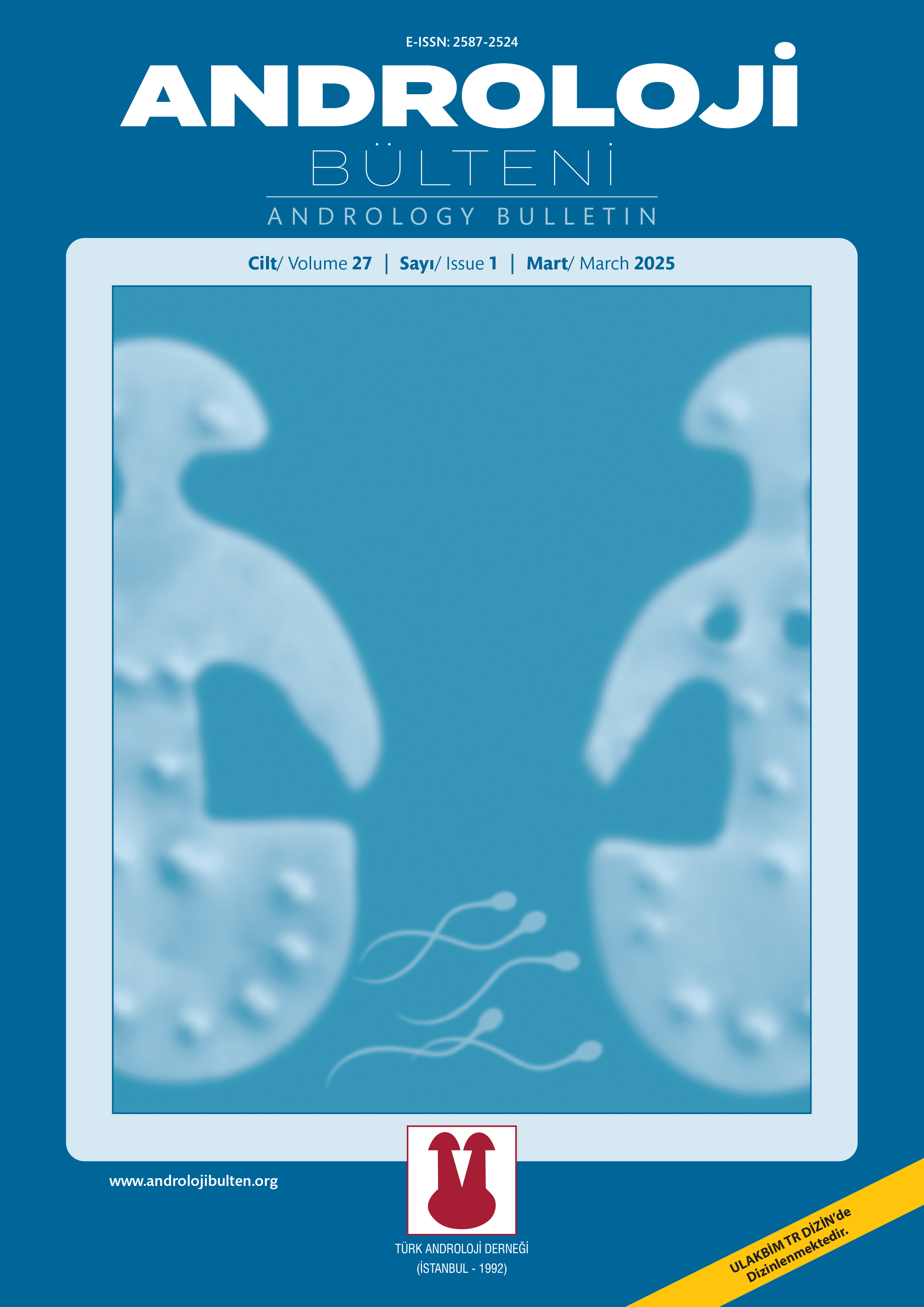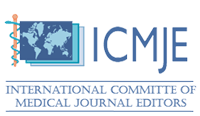INDEXES

Content of this journal is licensed under a Creative Commons Attribution-NonCommercial 4.0 International License.
Volume: 23 Issue: 4 - 2021
| 1. | Cover Page I |
| 2. | Reviewers Pages II - III |
| 3. | From the President Page IV |
| 4. | From the Editor Page V |
| 5. | Contents Page VI |
| ORIGINAL ARTICLE | |
| 6. | The effect of surgical procedures due to distal hypospadias on adult sexual functions Kubilay Sarıkaya, Çağrı Şenocak, Fahri Erkan Sadioğlu, Muhammed Arif İbiş, Ömer Faruk Bozkurt doi: 10.24898/tandro.2021.81598 Pages 219 - 223 OBJECTIVE: Evaluation of the sexual functions in adults who have undergone surgery for distal hypospadias in childhood, according to the type of operation performed. MATRERIAL and METHODS: A total of 48 adult male participants who underwent a single-session distal hypoapadias operation during childhood were included in the study. Participants were divided into four groups according to the type of operation performed: meatal advancement and glanuloplasty (MAGPI), urethral advancement and glanuloplasty (URAGPI), glanular approximation plasty (GAP) and tubularized incised plate urethroplasty (TIPU). Participants’ international index of erectile function -5 score (IIEF-5), premature ejaculation diagnostic tool (PEDT), orgasmic function score (OF), sexual desire score (SD), intercourse satisfaction score (IS) and overall satisfaction score (OS) were determined and groups were compared. RESULTS: It was determined that 12 (25.0%) of the participants had MAGPI, 9 (18.8%) URAGPI, 9 (18.8%) GAP and 18 (37.5%) TIPU procedure. The median IIEF-5 score of the participants was 22.5 (21.25–24) in the MAGPI group, 21 (16–23.5) in the URAGPI group, 23 (21.5–24.5) in the GAP group, and 22.5 (20.75–24) in the TIPU group (p=0.201). The median PEDT score of the participants was 5.5 (4–7.75) in the MAGPI group, 6 (4.5–11.5) in the URAGPI group, 6 (2.5–7.5) in the GAP group, and 5.5 (3.75–7) in the TIPU group (p=0.813). There was no significant difference between the groups in terms of median OF, SD, IS and OS scores (p=0.899, p=0.316, p=0.107 and P=0.504, respectively). CONCLUSION: It was determined that the erectile function and premature ejaculation parameters of adults who had undergone singlesession distal hypospadias surgery during childhood were not affected by the type of operation performed. |
| 7. | What are the variables predicting dyadic adjustment in men with erectile dysfunction and/or premature ejaculation? Sex roles, depression, anxiety, stress, personality traits and self-esteem Gökay Ata, Özden Yalçınkaya Alkar, Fatih Hızlı, Halil Basar doi: 10.24898/tandro.2021.98470 Pages 224 - 231 OBJECTIVE: The aim of this research is to determine the variables that predict dyadic adjustment of individuals diagnosed with erectile dysfunction and/or premature ejaculation. For this purpose, sex roles, depression-anxiety-stress and personality traits variables were included in the study. MATRERIAL and METHODS: Data were collected from 101 married individuals, aged 26–76, diagnosed with erectile dysfunction and/or premature ejaculation. Then, correlation analysis and then hierarchical regression analysis were performed to examine the relationships between variables. RESULTS: It was found that there were significant relationships between the sex role of femininity, depression-anxiety-stress, neuroticism, openness to experience, negative valence and dyadic adjustment. In addition, it was found that neuroticism and openness to experience did not predict dyadic adjustment, while femininity, openness to experience, negative valence, and depression-anxiety-stress variables predicted dyadic adjustment. CONCLUSION: While the relationship satisfaction of individuals diagnosed with erectile dysfunction and/or premature ejaculation increases as the feminine sex role and personality trait open to experience increase; It is observed that as the negative valence personality trait and depression-anxiety-stress level increase, marital satisfaction decreases. |
| 8. | The effect of JJ stent placement on sexual functions in male and female patients who underwent ureterorenoscopic surgery for ureteral stones Arif Kalkanlı, Cem Tuğrul Gezmiş doi: 10.24898/tandro.2021.57224 Pages 232 - 237 OBJECTIVE: The purpose of this study is to investigate the effects of JJ stent placement following ureterorenoscopic ureter stone (URS) treatment on sexual functions of male and female patients. MATRERIAL and METHODS: 48 female and 76 male patients who underwent URS surgery between May 2020 and July 2021 were included in the study. During the first examination, creatinine level, urianalysis results, and urinary CT findings were recorded for each patient as well as their age, BMI and stone burden. International Index of Erectile Fuction (IIEF-5) and Female Sexual Function Inventory (FSFI) were answered for a total number of three times (first preoperatively, and then on the postoperative first and third month) by male and female patients, respectively. Second measures of patients for whom JJ stent was used were taken when they applied for the removal of the stent. All patients received CT on the postoperative first month to assess the presence of possible residue stones. RESULTS: Mean IIEF-5 scores of male patients was 24.45±8 preoperatively, decreasing to 18.47±6.73 on the first postoperative month, and increasing to 23.95±8.55 on the third postoperative month (p<0.01). For female patients, mean FSFI value was 17.2±7.7 preoperatively, decreasing to 12±5.12 on the first month, and increasing to 7.8±7.9 on the third (p<0.01). Inquiry form scores of both male and female patients to whom JJ stent was placed showed a significantly higher decrease compared to patients for whom JJ stents were not used (IIEF-5: 23.33% vs 31.12%; FSFI: 21.25% vs 30.88%). CONCLUSION: Temporary sexual dysfunction is likely to develop following URS procedures. Our results indicate that placement of JJ stent increases the severity of the sexual dysfunction. |
| 9. | Inaccurate knowledge, attitudes, and beliefs of youth about sexuality during pregnancy Elif Dağlı, Feyza Aktaş Reyhan doi: 10.24898/tandro.2021.61482 Pages 238 - 243 OBJECTIVE: Myths about sex are defined as unscientific, false, and exaggerated beliefs about sexual matters. Sexuality myths are especially prevalent among young people. For this reason, it is important to reveal young people’s attitudes towards and knowledge about sexuality myths. This study was conducted to determine young individuals’ inaccurate knowledge, attitudes, and beliefs about sex life during pregnancy. MATRERIAL and METHODS: This descriptive study was conducted at the higher school of a public university. The population of the study consisted of 2485 students, and the sample included 493 students. The study data were collected via a personal information form and the Sexual Myths during Pregnancy Scale. Frequency tables and descriptive statistics were used to interpret the findings. Consistent with nonparametric methods, Mann-Whitney U, Kruskal-Wallis H tests, and Bonferroni correction statistics were employed. RESULTS: The mean age of the students was 21.19±1.86 (years), and 56.4% were female. It was determined that 59.8% of the students had difficulty sharing sexuality issues, 92.7% did not talk about sexuality in their families, 80.9% had not received sexual health education, and that 97.2% had not received sexual health education during pregnancy. A statistically significant difference was found in terms of the scores on the pregnancy and sexuality, anxiety about the baby, sex/attraction, and anxiety about pregnancy sub-dimensions and total scores on the scale of sexual myths according to the status of having received sexual health education (Z=-8.820, p=0.000; Z=-9.494, p=0.000; Z=-10.902, p=0.000; Z=-11.684; p=0.000; Z=-12.950; p=0.000, respectively). CONCLUSION: It was determined that the majority of the young people in the study had not received sexual health education and that these young people had more inaccurate knowledge, attitudes, and beliefs about sexuality during pregnancy. |
| 10. | Androgen levels and sexual dysfunction in polycystic ovary syndrome Selvinaz Rümeysa Erol, Pınar Kadıoğlu doi: 10.24898/tandro.2021.75002 Pages 244 - 249 OBJECTIVE: We aimed to examine sexual function and relationship between sexual function and androgen levels in polycystic ovary syndrome (PCOS). MATRERIAL and METHODS: Twenty-five patients diagnosed with PCOS and 25 age, gender-matched controls were enrolled into the study. Subjects were evaluated with female sexual function index (FSFI) and Beck Depression Inventory (BDI) questionnaires. Free testosterone, total testosterone, dehydroepiandrosterone sulfate (DHEA-SO4), androstenedione, prolactin, sex hormone binding globulin (SHBG), follicle-stimulating hormone (FSH), luteinizing hormone (LH) and estradiol levels were measured and free androgen index (FAI) was calculated. We compared between patients and control groups these values. RESULTS: Total FSFI score 26.17±4 was in the PCOS group whereas, healthy women had a total FSFI score of 28.61±4.68. FSD was diagnosed in 4 of 25 patients (% 16) while 5 of 25 (% 20) healthy women had FSD (p=0.57). There is no statistically significant difference between sexual desire (p=0.89), arousal (p=0.10), lubrication (p=0.057), orgasm (p=0.18) and satisfaction domain (p=0.78) scores. The sexual pain score (p=0.002) was found to be significantly lower in women with PCOS. BDI scores was significantly higher in PCOS women (p=0.002). No correlation was seen between androgen level and FAI and total FSFI score and domain score. CONCLUSION: Scores related to sexual desire, arousal, lubrication, satisfaction and orgasm disorders in PCOS patients are similar to those of control individuals, while scores for depression are higher than control individuals. No correlation was found between total FSFI, desire, arousal, lubrication, orgasm, sexual satisfaction scores and androgen levels. |
| REVIEW | |
| 11. | Reproductive health problems in women with disabilities and nursing approach Mevlüde Alpaslan Arar, Nülüfer Erbil, Fatma Yıldırım doi: 10.24898/tandro.2021.16870 Pages 250 - 255 Although sexual and reproductive health (SRH) services and access to these services have increased throughout the world, there are still major barriers to access to SRH especially for rural residents, the poor and the disabled. According to the World Disability Report, 15% of people live with a physical, sensory, intellectual or mental disability, and 80% of these disabled individuals are in low and middle income countries. Access of disabled women living in low and middle income countries to SRH services is faced with inequalities due to infrastructure and education problems in the field of health services for people with disabilities. The vast majority of women with disabilities cannot have a say in sexual and reproductive health, they are regarded as genderless and are considered to have no reproductive rights. It is noteworthy that the disabled have problems with sexual life, family planning, reproductive cycle, menstrual hygiene behavior, sexually transmitted diseases and adaptation to parenthood. In this review, it is aimed to describe SRH problems experienced by women with disabilities, to raise awareness about this issue in the society, and to guide nursing approaches developed for these problems. |
| 12. | A current look at the cultural, economic, psychosocial, and sexual aspects of infertility: Basic nursing approaches Hüsne Yücesoy, Fatma Yıldırım, Ebru Şahin doi: 10.24898/tandro.2021.97360 Pages 256 - 263 Having children is perceived as gaining status and value in many cultures worldwide. Having children in Turkish society is an indispensable phenomenon with psychological, social and economic dimensions. Infertility is a vital crisis, which can affect the families and social environments of couples and has cultural, religious and class aspects along with psychological, social and medical problems. Although individuals’ reactions to infertility differ individually, they generally have similar aspects. Infertility is a stress factor that impairs quality of life and can lead to sexual incompatibility between spouses. Also, infertility brings an additional economic burden to couples and may cause tension, violence and divorce among couples. While improvements in reproductive techniques are hope for individuals in one way, they also create situations such as loss of control, sadness, stigmatization especially in women. Nurses have an important role in providing consultancy and support to infertile individuals during this crisis which is very difficult to deal with. |
| 13. | Micro-TESE in non-obstructive azoospermia: Major innovations Kasım Emre Ergün, Barış Altay doi: 10.24898/tandro.2021.47704 Pages 264 - 268 In the microdissection TESE (micro-TESE) method, which is used as the gold standard method for sperm retrieval in men with nonobstructive azoospermia, since 1998, when it was first defined, there has been a significant increase in sperm retrieval rates. In order to predict the success of micro-TESE preoperatively, up-to-date studies are carried out, especially on ultrasonography, testicular spectroscopy, seminal plasma extracellular vesicles. At the same time, new techniques such as mini-incision micro-TESE and longitudinal tunica albuginea incision are being developed in order to achieve more successful results with less tissue damage during surgery. The use of new technologies such as microfluidic systems in micro-TESE seems promising for more efficient results at the sperm sorting stage. |
| 14. | Role of microRNAs in the pathophysiology of varicocele-related infertility Neslihan Hekim, Sercan Ergün, Sezgin Güneş doi: 10.24898/tandro.2021.76768 Pages 269 - 277 Varicocele is considered the most common treatable cause of male infertility, and possible pathophysiological mechanisms have been proposed to explain the effect of varicocele on fertility. However, the molecular etiology of infertility associated with varicocele is still unclear. MicroRNAs (miRNAs) are small non-coding RNA molecules that regulate the expression of genes by binding complementary base sequences in target mRNAs. Apart from its function in many physiological cell processes, it has been reported that the irregularity of miRNAs expression plays a role in the development of many diseases. In this review, the possible roles of seminal, testicular, and spermatozoal miRNAs in varicocele-related infertility were discussed. Abnormal expression of tissue-specific miRNAs is associated with certain male reproductive system disorders. Thus, focusing on the role of such miRNAs in varicocele pathophysiology could illuminate the molecular mechanisms of varicocele-associated male infertility and create the potential to find effective biomarkers and therapeutic agents. |
| 15. | Premature ejaculation: current and future treatments Erhan Ateş, Hakan Görkem Kazıcı doi: 10.24898/tandro.2021.58569 Pages 278 - 289 Premature ejaculation is the most common form of sexual dysfunction among men. The pathophysiology of premature ejaculation appears to be multifactorial, implicating the need for multimodal therapeutic regimens to successfully treat prematüre ejaculation. Multiple treatment regimens have been shown to be effective in extending the time between penetration and ejaculation. These treatment modalities include everything from behavioral modifications and medications to diet alterations and majör surgery. The goal of the present article was to review the commonly used treatment regimens used in the treatment of premature ejaculation, as well as to introduce and discuss the newest treatment modalities and future treatment perspectives for premature ejaculation. |
| 16. | Publications and Congress Calendar of Andrology Pages 290 - 294 Abstract | |














